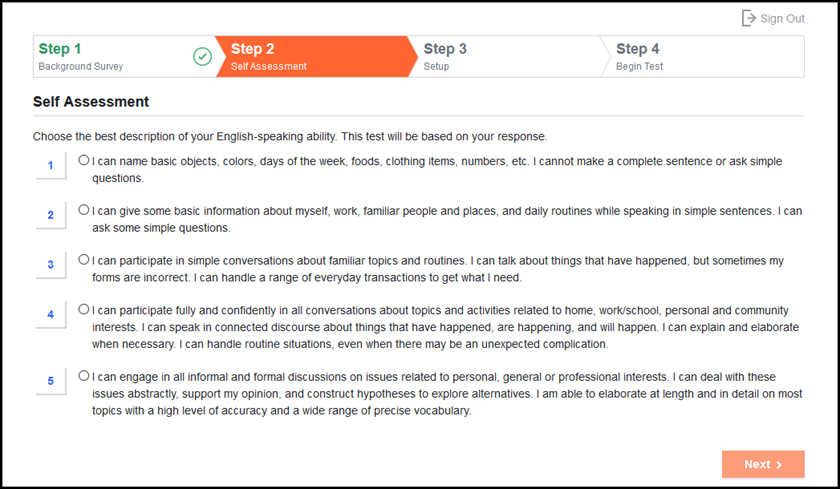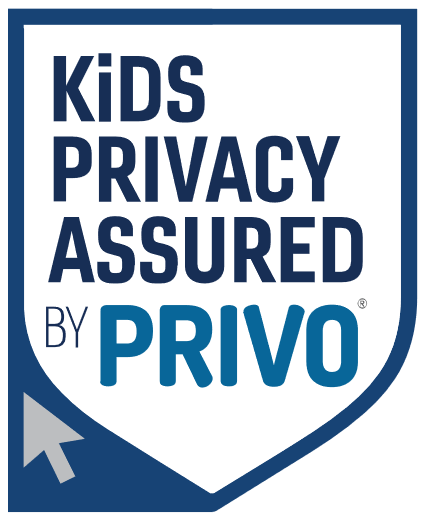ACTFL Speaking Assessment: The Oral Proficiency Interview - computer® (OPIc)
OPIc Demo Version
To experience a brief, 5-minute demo version of the OPIc, click here.
Jump to a section:
What is the ACTFL Oral Proficiency Interview - Computer (OPIc)?
The ACTFL OPIc is an internet-delivered test that provides valid and reliable oral proficiency testing on a large scale. It was developed in response to the increased worldwide demand for the testing of oral language proficiency. The testing format offers more flexibility for testers. The internet-delivered assessment emulates the "live" OPI, but the delivery of questions is through a carefully designed program and via a virtual avatar, allowing the test to be taken on-demand and at a time convenient to the candidate and proctor.
What is the goal of the OPIc?
The goal of the OPIc is the same as the OPI: to obtain a ratable sample of speech which a rater can evaluate and compare to the performance against the proficiency levels described in ACTFL Proficiency Guidelines 2024 – Speaking, Interagency Language Roundtable Language Skill Level Descriptors – Speaking, or the Common European Framework of Reference for Languages (CEFR), depending on the type of language proficiency certification needed.
OPIc Rating Scale
The current version of the OPIc rates the full range of the ACTFL scale, from Novice through Superior. It assesses level 0-3 on the ILR scale and A1-C2 on the CEFR scale.
The popularity and reputation of the OPIc has resulted in a significant increase in demand for the OPIc. More and more commercial enterprises, international organizations, and government agencies recognize the usefulness of the OPIc as a reliable tool to determine the linguistic capabilities of their personnel. Universities and schools use it for entrance and exit requirements, program evaluation, credit, and teacher credentialing. The ACTFL OPIc has been favorably reviewed for college credit. ACTFL provides these college credit recommendations to institutions of higher education for their consideration in awarding college credit for demonstrated oral proficiency in world languages. For more information on college credit recommendations, click here.
To download an ACTFL Academic Assessment Catalog, including the ACTFL proficiency guidelines, click here.
To download an LTI Assessment Catalog for Commercial Companies and Government Agencies, click here.
What is the format of the OPIc?
The OPIc structure is based on one of five test forms, which target a specific range of proficiency. Having targeted test forms keeps the test to under 40 minutes.
Form 1 – Targets proficiency levels Novice Low through Novice High, though any rating from Novice Low through Intermediate Low can be assigned.
Form 2 – Targets proficiency levels Novice High through Intermediate Mid though any rating from Novice Low through Intermediate High can be assigned.
Form 3 – Targets proficiency levels Intermediate Mid through Advanced Low, though any rating from Novice Low through Advanced Low can be assigned.
Form 4 – Targets proficiency levels Advanced Low through Advanced Mid, though any rating from Intermediate High through Advanced High can be assigned.
Form 5 – Targets proficiency levels Advanced High & Superior, though any rating from Advanced Low to Superior can be assigned.
Taking the ACTFL OPIc
Before beginning the OPIc, test takers complete a Background Survey and a Self-Assessment. They also receive a full overview and explanation of OPIc procedures, including a sample test question. These instructions can be delivered in the test taker's native language (English, French, German, Korean, Japanese, Chinese-Mandarin, and Spanish).
Background Survey: Selecting Topics for the Assessment
The Background Survey is a questionnaire that gathers information about the test taker's work, school, home, personal activities, and interests. The test taker completes the survey and the answers determine the pool of topics from which the program will randomly select questions. The variety of topics, the types of questions, and the range of possible combinations the program can generate allow for individually designed interviews. Even if two test takers selected the same combination of Background Survey responses, the resulting test would not be the same.
Self-Assessment: Determining the Level of the OPIc
The Self-Assessment provides six different descriptions of how well a person can speak a language. Test takers select the description that they feel most accurately describes their language ability. Samples of speech accompany each descriptor; thus test takers can also listen to samples to help select the most appropriate description aligned with their speaking ability. The Self-Assessment choice determines which one of five OPIc test forms (Form 1, Form 2, Form 3, Form 4, or Form 5) is generated for the specific individual. The choices made by the test taker in response to the Background Survey and the Self-Assessment assure that each test taker receives an OPIc that targets their range of ability and provides questions on topics familiar to the candidate. Below are the self-assessment statements from the U.S. version of the OPIc to Superior.

OPIc Test Administration
The OPIc is delivered via the internet and on any secure computer or tablet that meets the minimum technical specifications, which can be accessed by clicking here.
The OPIc provides detailed test instructions and directions on how to listen to the questions and record answers. In order to ensure that the test taker understands these instructions, a sample question is provided for the test taker to practice the functionality of the OPIc. The test taker has the opportunity to re-review the instructions and sample question before beginning the test. The test taker then begins the OPIc test.
Ava – the OPIc Interviewer – An Avatar
Ava is an avatar figure that personifies the OPIc interviewer. Test takers listen to her questions and respond to her. Having the picture of Ava on the screen helps to engage the test takers in conversation and mimics a one-on-one conversation with a native speaker of the target language.
The first part of all interviews is: "Let's start the interview now. Tell me something about yourself." This part functions as a warm-up and an opportunity for the speaker to begin using the language.
How is the OPIc rated?
As part of the certification process, an OPIc can be rated according to the ACTFL scale, the Interagency Language Roundtable (ILR) scale, or the Common European Framework of Reference for Languages (CEFR) scale. An ACTFL OPIc reports a rating between Novice and Superior on the ACTFL scale. An ILR OPIc rating reported is between ILR 0 (No Proficiency) and ILR 3 (Professional Proficiency). A CEFR OPIc rating is between A1 and C2.
The OPIc assesses language proficiency in terms of the ability of the candidate to use the language effectively and appropriately in real-life situations. It does not address when, where, why, or the way in which a speaker has acquired his/her language. The OPIc is not an achievement test assessing a speaker's acquisition of specific aspects of course and curriculum content, nor is it tied to any specific method of instruction. The OPIc does not compare one individual's performance to others, but each individual performance to the assessment criteria of the rating framework.
Commercial OPIcs are single rated; an ACTFL Certified OPIc rater rates the sample by identifying the speaking proficiency level met by the candidate's performance.
In an Official/Certified OPIc, the OPIc is blindly rated by two ACTFL Certified OPIc raters whose independent ratings must agree before an official rating is released.
Who rates the OPIc?
ACTFL Certified OPIc raters are highly specialized language professionals who have completed a rigorous training process that concludes with a rater's demonstrated ability to consistently rate samples with a high degree of reliability.
OPIc raters are expected to respect and follow OPIc rating protocols, procedures, and guidelines. They comply regularly with ongoing renorming and quality assurance practices. Confidentiality and exclusivity are important practices for all OPIc raters. Work with the OPIc rating process must be done exclusively through Language Testing International, the ACTFL Testing Office.
How reliable is the OPIc?
The reliability of ACTFL assessments is well documented by 3rd-party studies, and the rigor of ACTFL's selection, training and certification process for testers and raters, along with ongoing monitoring, norming and re-certification, are second to none.
How do I request an OPIc?
For organizations wanting to schedule an OPIc to test the language ability of candidates, you must set up a free account with Language Testing International. We will collect some basic administrative information and then provide access to a secure web-based scheduling utility. Using this utility, the organization can request assessments, track those requests, confirm appointments, and see results. Because the OPIc is internet-based, organizations can arrange for candidates to take the assessment in a proctored setting at any time. All that is needed is a computer or tablet meeting the minimum specifications, detailed here, in an appropriate test environment. Remotely proctored tests must be completed on a computer with a webcam and microphone. Results of assessments are also posted and stored on the client utility website, allowing organizations to track their testing activity easily in a single location.
Individuals wanting to test and certify their speaking ability in a target language can order and take the assessment by selecting the appropriate Language Proficiency Certification based on their need. To view individual language proficiency certification options, click here. The actual test is taken via a computer with an internet connection, webcam, headset with earphones, and microphone and is proctored via LTI's remote proctoring services.
How is the OPIc proctored?
Organizations can arrange to proctor OPIcs on location. The tests must be proctored by an authorized, responsible individual, ideally a member of the HR department or faculty of the organization requesting the assessment. This individual, nominated by the organizing agency, will sign a form and provide it to LTI in advance of the assessment, undertaking to guarantee the identity of the candidate and the conditions under which the test is taken.
Individuals can arrange to take the test via LTI's remote proctoring program by signing up for one of the Language Proficiency Certification options offered to individuals by LTI. To view individual language proficiency options, click here.
What is the cost of the OPIc?
Organizations, please fill out a Contact Us form to learn more.
Individuals can view the cost of remotely proctored, language proficiency certificate programs by clicking here.
In what languages is the OPIc available?
Arabic, Chinese (Mandarin), English, French, German, Italian, Japanese, Korean, Pashto, Persian Farsi, Portuguese, Russian, Spanish, and Vietnamese.




